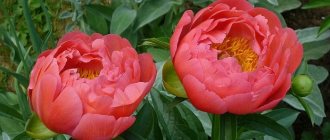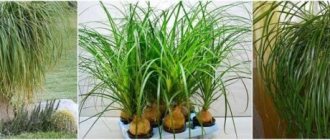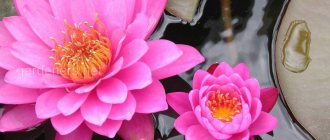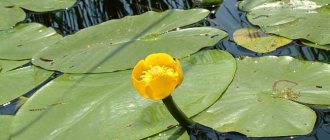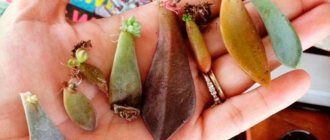The water lily, also known as the nymph, became known thanks to one of the ancient Greek legends, according to which an unrequited nymph in love disappeared forever in the depths of the sea, turning into a flower. For a long time, the water lily has been associated with the mystical inhabitants of the underwater world.
Many ancient Greek drawings, modeling and carvings that have survived to this day testify to the beauty and reverence of this amazing plant, which was used to decorate one’s home, to perpetuate the image of a flower in modeling and to paint ancient temples with images of water lilies. The water lily or white lotus was immortalized in the whole complex of Egyptian buildings near the Temple of Amun.
Water lily, plant description
The nymphea flower is a perennial aquatic plant with a long stem and a well-developed root system, hidden under a layer of silt and water.
Water lilies stay on the water due to powerful root processes with which the plant clings to the ground and wide floating leaves. At the nodes of a long, strong stem there are buds, from which, during the growing season, large leaves develop, some of which may be in the water, revealing only the uppermost and largest green “plates.” The leaf size varies from 25 to 35 cm, the plate is dense, dark green in color.
Nymphea blooms begin in the spring, revealing large water lilies in white, pink, pale yellow, purple and blue colors.
One of the interesting features of the water lily is its ability to close at night and go under water, restoring the freshness of the flower for a new day. The flower petals are very delicate, oval-pointed, cream, red or pink in color. Inside the bud are the stamens and pistil. The size of the flower is about 15-25 cm. The fragrance of the blooming nymphea covers an impressive territory.
When a water lily is pollinated, a fruit appears on the peduncle in the form of a seed capsule; it reaches full maturity under water, opening there and producing seeds. Water lily seeds first stay on the surface thanks to a thick slimy secretion, then, washed with water, they become heavier, sink to the bottom of the reservoir and grow.
The yellow core of a large flower of the Nile water lily was considered the temporary refuge of the sun god Ra, from the flower he showed the sun to the world. The Egyptians' belief in mystical legends prompted the priests to use the blue lotus in mummification rituals.
When opening the sarcophagus of Ramses, the remains of flowers were found (the mummy was showered with them), which turned out to be water lilies.
Water lilies are decorative in nature and are highly in demand for decorating artificial reservoirs. Gardeners often think about planting a water lily on their site, but they doubt whether they will be able to create conditions for the growth and development of the flower. Speculation is easily dispelled, thanks to the ability of the water lily to grow even in small (artificial) reservoirs with suitable temperature and soil.
Thanks to its presentable and memorable appearance, the water lily has long won the hearts of true connoisseurs of natural beauty. Flower growers all over the world breed water lotus as an ornamental crop.
Reproduction
The reproduction process occurs thanks to rhizomes and seeds. Even with a strong drop in water level, it will bloom and bear fruit. There are several conditions for a water lily to live:
- Bright places.
- Fresh water.
- Silty soil.
- When in water, it will easily overwinter and survive other weather disasters.
Reproduction of water lilies is possible by divisions, rhizomes, and seeds
Note! White water lily is grown in artificial ponds for use in the production of medicines. It is also a valuable ornamental plant.
Giant water lily in an artificial pond
Growing
It is possible to grow a water lily in artificial conditions, but it is not easy. Experts in landscape design of underwater gardens share tips:
- The water lily has a pronounced dormant period - winter.
- Transplantation and planting can be carried out from May to October.
- Lilies should be placed on an area of 0.5 to 4 square meters. m depending on age and size.
- In order to contain entire collections, you need a large reservoir. Optimal conditions are a 60% free reservoir.
- If the pond is not drained for the winter, you can plant the water lily directly in the ground.
- If drained reservoirs are used for cultivation, then the plant must be placed in containers with holes for drainage.
- The substrate is silt, which is taken from the bottom of the river. If this cannot be done, then use compost and garden soil with sand.
Types of water lilies
The water lily has become widespread throughout the world and has absorbed about half a hundred species. The palette of shades of petals and the size of buds of nymphs is varied. The Victoria water lily is considered the largest of all; with its impressive size and remarkable appearance, it has won the hearts of many gardeners. The closest relative of the water lily, the water lily, is less noticeable, but is not inferior to it in decorative qualities and popularity.
White water lily
Inhabits all of Eurasia, as well as Africa. The large water lily has impressive foliage of about 35 cm and large, milky flowers, reaching a diameter of about 20 cm. The root system is strong, located on the surface of the soil, tenaciously grasping the silt with long root processes. The root length is about 65 cm. The white water lily has underwater stems that form an entire bush. One water lily can cover quite a lot of free space in a pond. The white nymphea begins to bloom in the summer and lasts about three weeks, releasing large white water lilies with a yellow core to the surface.
Red water lily
It has a beautiful shade of flowers from dark pink to red, medium buds.
Blooming water lilies exude a pleasant, lasting aroma.
The root system is shallow and well developed. It has one main stem and several additional ones. The diameter of the flowers ranges from 12 to 20 cm. The leaves are fleshy, bright green, and reach about 25 cm in size.
Blue water lily
One of the very first and famous species. In another way, a species is an evolutionarily established collection of individuals characterized by a single... called the Egyptian lotus or Egyptian lily. The blue water lily inhabited the coastal zone of the Nile River, then began to spread throughout Africa, India and Thailand. The foliage of the plant is sinewy, large, about 35 cm long. Flowers with such large foliage seem small, reaching a size of 16-20 cm. The shade of the petals varies, from sky blue to cornflower blue, lilac and blue.
Tiger water lily
It is distinguished by large dark green leaves, uneven tiger color.
The distinctiveness of the tiger water lily is created by the pattern of the leaves (brown and red spots). It is seasonal, does not tolerate frost well, and is suitable for growing in aquariums. Africa is considered the birthplace of the tiger nymph. The flowers are small, white or cream in color. The root system is well developed and does not tolerate fast currents and cold water bodies.
Water lily Victoria Regia or Amazonian nymphea
Another speciesA species is an evolutionarily established collection of individuals characterized by a single... impressive size. The Victoria water lily was discovered by the German botanist and naturalist Eduard Pelling in the 19th century. The Amazonian water lily blooms only once a year, blooming only at night, and sinks under the water before dark.
The shade of perhaps the largest flower changes during the flowering process from white to pink. When in full bloom, the Amazonian water lily can reach 35 cm. Victoria Regia has a persistent, noticeable aroma, and its foliage can support the weight of a teenager.
Yellow water lily
Yellow water lily is a perennial, with a well-developed root system lying deep in the ground. It has underwater small foliage with jagged edges, on short petioles.
The above-water floating leaves are ovoid, large, up to 20 cm in diameter. The flowers are large, green on the outside and yellow on the inside. They reach a size of about 17 cm. Flowering occurs in June and lasts almost until September.
water lily
Water nymph, from the water lily family. Botanically, it is similar to the white water lily; it has medium-sized floating foliage and small underwater leaves. The flowers are emergent, reach medium size, have a cream color and a bright yellow center. Water lily is used in pharmacology, and starch is obtained from the roots.
The most popular varieties of water lilies among flower growers were recognized as:
Alba (large, snow-white flowers), Gold Medal (yellow flowers with a large core), James Brydon variety (very beautiful variety with large, fluffy, burgundy corollas), Blue Beauty (has memorable blue flowers with a yellow core), Rosea (pink flowers, with a bright purple cup).
Rules for planting nymphs
You can purchase a nymphaeum seedling at a garden center or online store. When you decide to grow a water lily, you need to remember the basic rules for planting it.
Best time to plant
Leaf spotting is caused by a fungus.
When purchasing a seedling, you should pay attention to the absence of signs of disease and rot. The nymph should be planted immediately, without waiting for the soil in the container to dry. The optimal time for planting is May or June.
Place in the pond and water
Water lilies love sunlight and refuse to bloom in low light, so the plants should be placed in an open space. During the midday hours, partial shade from closely growing trees and shrubs is allowed. For normal development, the nymph must see the sun for at least 5-6 hours every day.
The chemical composition and acidity of the water do not play a special role - the water lily will feel great both in a silted pond and in a tub of tap water. Pools with fountains are not suitable for growing water lilies: splashes of water that constantly fall on the leaves will interfere with air exchange and cause rotting and death of the plant.
Choosing a pot and soil
The rhizomes of water lilies grow not in height, but in width, so for planting you need to choose wide containers made of materials that do not rot or oxidize under the influence of water. The best option is pots, containers, baskets made of plastic or stainless metal. Containers with a height of 15-25 cm are best suited; the diameter can be any (within reasonable limits).
To grow nymphs, experts advise using not mesh baskets, but basins and boxes without holes. A closed container will prevent the leaching of nutrients from the soil and prolong the growing season of plants. There is no need to be afraid that the substrate and rhizome will “suffocate” in a solid container. The main root of the flower is located on the surface of the soil, so its rotting is excluded.
When preparing a substrate for water lilies, it is recommended to use garden soil enriched with humus or rotted manure at the rate of 100-300 g per 10 liters of soil. You can add river sand, clay and peat, but not more than 1/3 of the total volume of the mixture. For active growth and abundant flowering, experienced nymph growers advise placing any long-acting mineral fertilizer on the bottom of the container:
- Ava;
- Apion;
- Basacote;
- Osmocote;
- Fertika station wagon;
- Plantella.
To prevent nutritional supplements from being washed away by water, it is better to roll them into clay balls or wrap them in thick paper.
Landing algorithm
Planting a nymph.
Even a novice summer resident can cope with planting a nymph:
- Fill the plastic container with soil so that 3-4 cm remains from the surface of the substrate to the edge of the container.
- Make a depression in the center, place the main root of the nymphea in it and sprinkle with soil.
- Cover the surface of the substrate with a layer of pebbles, river sand or clay. In reservoirs inhabited by fish or amphibians, it is preferable to use pebbles, gravel or granite crushed stone. After all the manipulations, the growth point (the place from which young shoots appear) should remain above the soil surface. If you bury it, the water lily will die over time.
- Place the pots at a depth of 10-20 cm from the growth point, and then gradually move to the desired depth.
To fulfill the conditions of the last paragraph, you can act in two ways. In the first case, when regulation of the filling of the reservoir is impossible, you will have to make a stand for the container from available materials - ceramic bricks or large stones. In pools and tanks, where the height of the water layer can be easily adjusted, you need to increase the water level by a few centimeters every day.
In deep reservoirs (≥ 1 m), where in winter the water does not freeze to the very bottom, the nymph can be planted in the bottom soil and secured - press the root with a stone or secure with wire staples.
Growing water lilies
To ensure that the process of growing water lilies does not cause unnecessary trouble, take the choice of planting material seriously. It’s not for nothing that they say: “The miser pays twice.” Buy planting material in specialized stores or borrow from trusted gardeners.
Warm summer months are considered a suitable period for planting water lilies. The plant can be immediately planted on the bottom of the reservoir, but it is worth considering that water lilies are terrified of frost and cold, so looking ahead, you should take this fact into account and plant the plant in a deep container, and only then install it on the bottom of the reservoir, this will make it easier to remove the flower and send for the winter.
You can get a planting substrate for water lilies in the store by purchasing ready-made soil for water lilies, or you can prepare it yourself. The optimal composition can be considered a layer of peat of 4 cm and 10 cm of turf soil with sand in equal parts.
During planting, make sure that the growth bud is on the surface of the pot; stick feeding balls made of clay mixed with mineral fertilizers onto the roots of the water lily.
3-4 pieces the size of a paintball ball will be enough. Afterwards, the rhizome is placed in a pot on a layer of peat and covered with prepared soil mixture on top, leaving room for a layer of river pebbles to weigh it down.
Immediately after planting the water lily, the plant must be placed at the bottom of the reservoir; the optimal depth for immersing the pot is usually calculated based on the varietal data of the plant. Dwarf varieties are placed at a depth of half a meter, tall ones from a meter or more; the growth bud of a water lily will serve as a guide for you.
In order for the water lily to develop faster, it is better to place it in shallow water before the first leaves appear. When the first two floating leaves appear, the pot with the plant is deepened.
Plants planted on time will bloom in your first year of growing season, and some varieties will delight you with even several blooms.
When planting, pay close attention to the cold resistance of the variety you choose. Some speciesA species is an evolutionarily established collection of individuals, characterized by a single ... water lilies can survive a mild winter without additional shelter, for example, a water lily or a snow-white water lily. Most often, high survival rates of water lilies are observed only in tall varieties whose rhizomes lie deep under water.
But if in your region the winter is long and harsh. For the winter, water lilies should be removed from the reservoir and sent to a dark, cool place, and with the onset of spring, after the ice has melted, returned to the reservoir.
Water lily for a pond: species diversity
Size
In the case of water lily breeding, this parameter becomes the leading one. Today, plant breeders have bred the plant in hundreds of variations. The main classification comes down to the size range:
- dwarf;
- small;
- average;
- large.
Caring for flowers and their reproduction capabilities may be similar, but planting will have a guaranteed individual method.
Dwarf nymphs with a circumference of 30–60 centimeters and a flower diameter ranging from 5–10 cm, are planted under water no deeper than 10–15 cm.
Dwarf nymph
Small water lilies, characterized by 10 - 15 centimeter flower cups and a total spreading of 60 to 120 cm, are buried 15 - 50 cm.
Small water lilies
Medium-sized plants, such as the snow-white water lily, occupy from one hundred twenty centimeters to one and a half meters of water surface and bloom with 15-18 centimeter flowers. They require a depth of 40-60 cm.
Medium-sized water lilies
The largest water lilies, with luxurious flowers up to 25 centimeters in diameter, spread out over 1.5 or even 2.5 meters on the water surface. Their habitat is reservoirs with a depth of at least half a meter. Planting them will be complicated by deep work, but the result will exceed expectations.
Large water lilies
Knowing this classification, you can easily select an assortment of ornamental plants for your country pond. If you don’t already have one, then first you need to figure out what type of water lilies you would like to grow, and prepare a foundation pit based on this.
Remember, you can only plant whatever your heart desires in a large body of water. Miniature varieties will also feel wonderful:
- in a shallow pond,
- tubs,
- barrel
Small water lilies can be planted in a barrel
Caring for water lilies in the garden
Nymphea is an unpretentious plant and caring for it will not be difficult. In their usual wild environment, water lilies grow without care, multiplying and blooming on time. However, do not allow the water lily to cover the surface of the water with its leaves; this may lead to the flowers becoming smaller.
Dead flowers and yellowed foliage should be removed from the pond to prevent the water from “blooming.” In order for the plant to produce more flowers, do not leave the water lily more than two floating leaves.
Make sure that the plant has enough space in your pond; do not plant too many nymphs in small reservoirs.
Small artificial reservoirs with standing water are subject to periodic cleaning. After removing the water lily for the winter, the reservoir should be drained and cleaned of dirt and debris, and with the arrival of spring, fill it with fresh, clean water, let it sit for about a week and begin planting the water lily again. A week before planting, the water lily should be watered with mineral fertilizers.
Care
In order for water lilies to germinate well and live for a long time, you need to remember some key rules for caring for them:
- Lighting. The reservoir should not be protected from sunlight; it should be exposed to natural color for at least several hours a day, which cannot be replaced by artificial color.
- Landing. In the case where the decorative pond is small in size, it is best to place the nymphs in an ordinary flower pot, basket or other container, and then lower it to the bottom. The smaller the size of the reservoir, the more frequent cleaning it needs. That is why the best solution would be a pot, because you can simply take it out, and then drain the water from the hole and replace it, unlike full-fledged growing plants, which not everyone can clean up.
- Fertilizer. In general, plants that grow on water do not require care. They have enough microorganisms and decomposed microelements living inside the reservoir. And special fertilizers are used only in extreme cases, or when transplanting a nymph, so as not to injure it.
- The soil. The more nutrients the soil stores, the faster the plants will grow and the better flowering the owner will expect. The main criterion for assessing soil is viscosity: clay mixed with garden soil in a ratio of 1:3, according to many, is the best solution for a small decorative pond.
Diseases and pests of water lilies
The water lily is not susceptible to disease and is extremely rarely attacked by insects. The plant has a fairly strong immune system.
However, in the hot months, stagnant bodies of water are often inhabited by the pitcher leaf beetle, a small brown beetle whose larvae devour floating leaves.
The method of combating it is simple: damaged foliage is removed, and the larvae will have to be collected manually, since most insecticides are dangerous for water bodies, causing its poisoning and the death of living creatures.
Another enemy of the “queen of ponds” can be called aphids. Small insects spoil the appearance of a flower and cause premature flowering of the plant. The fight against aphids involves only a mechanical method, for example, washing off harmful insects with a stream of water. Attracting entomophages to a pond can also be a life-saving option in pest control.
The main problem with the extinction of water lilies today remains not pests and diseases, but the constantly deteriorating ecology and human interference in the population of the plant species.
The drainage of water bodies and the collection of water lilies on an industrial scale led to the catastrophic extinction of this amazing and beautiful plant. Some speciesA species is an evolutionarily established set of individuals, characterized by a single... nymphs are already included in the Red Book and if “man” does not come to his senses, we may completely lose one of the most beautiful flowers on Earth.
Types of nymphs most suitable for home ponds
Nymphaea exists with leaves in many colors from pure green to various shades of brown or red. Aquariums use a number of selected hybrids that are most suitable for this purpose. Species commonly found in stores include Nymphaea pubescens and Nymphaea micrantha, which have brown leaves and with their color and shape offer an attractive contrast to other plants. A species that can be recommended for its decorative effect with spotted leaves is Nymphaea lotus, and this species is also usually always available in trade. There is one species found growing wild in Northern Europe, Nymphaea alba (White Water Lily). This type is very suitable for garden ponds, but requires quite a lot of space. However, there are several hybrids that are frost hardy and some require less space so they are better suited to smaller ponds.
Join our Facebook group
Preparing the plant for wintering
The water lily cannot overwinter in shallow reservoirs outside; this is true for all cases when freezing reaches the bottom.
Let's figure out a little how to prepare a nymph for winter. The best place for wintering may be the basement. Storing nymphs in the basement: simply take out the container in which the rhizomes are located and transfer it to the basement or other dark, cool place, but inaccessible to frost. If you are sure that your pond will not freeze to the bottom, then the water lilies can be left to overwinter in place. This applies to reservoirs with a depth of 0.5 m.
As you understand, water lilies are quite easy to grow at home. Create favorable conditions for them and admire the beautiful flowers.


